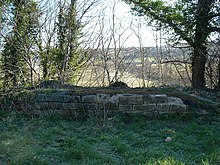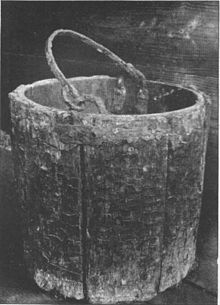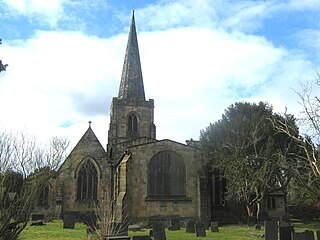
Duffield is a village in the Amber Valley district of Derbyshire, 5 miles (8.0 km) north of Derby. It is centred on the western bank of the River Derwent at the mouth of the River Ecclesbourne. It is within the Derwent Valley Mills World Heritage Area and the southern foothills of the Pennines.

Tutbury is a village and civil parish in Staffordshire, England. It is 4 miles (6.4 km) north of Burton upon Trent and 20 miles (32 km) south of the Peak District. The village has a population of about 3,076 residents. It adjoins Hatton to the north on the Staffordshire–Derbyshire border.
Robert I de Ferrers, 1st Earl of Derby was born in Derbyshire, England, a younger son of Henry de Ferrières and his wife Bertha. His father, born in Ferrières, Normandy, France accompanied William the Conqueror during his invasion of England. The family was rewarded with a grant of Tutbury Castle in Staffordshire and 114 manors in Derbyshire.
Robert II de Ferrers, 2nd Earl of Derby was a younger, but eldest surviving son of Robert de Ferrers, 1st Earl of Derby and his wife Hawise. He succeeded his father as Earl of Derby in 1139. He was head of a family which controlled a large part of Derbyshire including an area later known as Duffield Frith.

Milford is a village in Derbyshire, England, on the River Derwent, between Duffield and Belper on the A6 trunk road.
Duffield Frith was, in medieval times, an area of Derbyshire in England, part of that bestowed upon Henry de Ferrers by King William, controlled from his seat at Duffield Castle. From 1266 it became part of the Duchy of Lancaster and from 1285 it was a Royal Forest with its own Forest Courts.
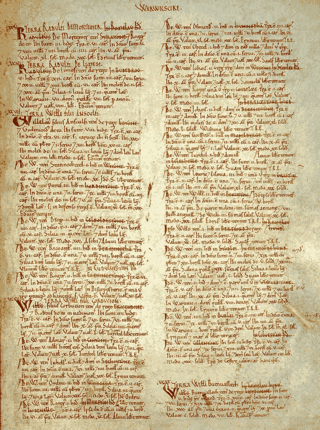
Henry de Ferrers, magnate and administrator, was a Norman who after the 1066 Norman conquest was awarded extensive lands in England.
William I de Ferrers, 3rd Earl of Derby was a 12th-century English earl who resided in Tutbury Castle in Staffordshire and was head of a family which controlled a large part of Derbyshire known as Duffield Frith. He was also a Knight Templar.
William II de Ferrers, 4th Earl of Derby, was a favourite of King John of England. He succeeded to the estate upon the death of his father, William de Ferrers, 3rd Earl of Derby, at the Siege of Acre in 1190. He was head of a family which controlled a large part of Derbyshire which included an area known as Duffield Frith.

Hazelwood is a village in Derbyshire at the lower end of the Pennines around five miles north of Derby, England. Ordnance Survey maps in the nineteenth century spelt it Hazzlewood. The population of the civil parish as of the 2011 census was 330.

Shottle is a village approximately 3 miles (4.8 km) south of the market town of Wirksworth in Derbyshire. The population of the civil parish at the 2011 Census was 266.
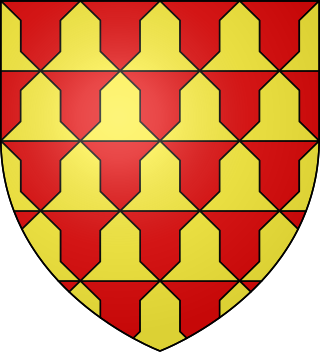
Robert de Ferrers, 6th Earl of Derby (1239–1279) was an English nobleman.

Pilsbury Castle was a Norman castle in Derbyshire near the present-day village of Pilsbury, overlooking the River Dove.

Shottle and Postern is a civil parish within the Amber Valley district, which is in the county of Derbyshire, England. Sparsely built up with much rural expanse, its population was 270 residents in the 2021 census. The parish is 120 miles (190 km) north west of London, 9 miles (14 km) north west of the county town of Derby, and 2+3⁄4 miles (4.4 km) equidistant of the nearest market towns of Belper and Wirksworth. It shares a boundary with the parishes of Alderwasley, Ashleyhay, Belper, Hazelwood, Idridgehay and Alton, Turnditch and Windley.
John de Ferrers, 1st Baron Ferrers of Chartley was the son of Robert de Ferrers, 6th Earl of Derby and Alianore de Bohun, daughter of Humphrey de Bohun and Eleanor de Braose, and granddaughter of Humphrey de Bohun, 2nd Earl of Hereford. He was both Seneschal of Gascony and Lieutenant of Aquitaine in 1312, the year of his death.

Melbourne Castle was a medieval castle in Melbourne, Derbyshire. It was built on the site of an earlier royal manor house that had provided accommodation for noblemen hunting in a nearby royal park in the reign of King John. Construction of the castle was started in 1311 by Thomas, 2nd Earl of Lancaster, and continued until 1322, shortly before his execution, but the work was never fully completed.
Tutbury Priory was a Benedictine monastery in Tutbury, Staffordshire, England, founded in 1080 by Henry de Ferrers as a dependency of the abbey of Saint-Pierre-sur-Dives in Normandy and completed in 1089, in memory of King William the Conqueror and his wife Queen Matilda of Flanders, also of Henry de Ferrers' own parents, and in thanksgiving for his own family: "in honour of holy Mary, the Mother of God ... and for the soul of King William and Queen Mathilda, and for the health of my father and mother, and my wife Berta, and my sons, Engenulph, William and Robert, and my daughters and all my ancestors and friends."

Peveril Castle is a ruined 11th-century castle overlooking the village of Castleton in the English county of Derbyshire. It was the main settlement of the feudal barony of William Peverel, known as the Honour of Peverel, and was founded some time between the Norman Conquest of 1066 and its first recorded mention in the Domesday Survey of 1086, by Peverel, who held lands in Nottinghamshire and Derbyshire as a tenant-in-chief of the king. The town became the economic centre of the barony. The castle has views across the Hope Valley and Cave Dale.

The Ferrers family were a noble Anglo-Norman family that crossed to England with the Norman Conquest and gave rise to a line that would hold the Earldom of Derby for six generations before losing it in rebellion. They also gave rise to several lines that held English peerages, the longest-living going extinct in the male line in the 15th century, as well as a Norman branch of the family that persisted into the 13th century. A French line persisted into the 16th century.
The Pilsbury family is a British family of Anglo-Norman origins. The family rose to its highest prominence within the counties of Derbyshire and Staffordshire within the United Kingdom and Minnesota, New England and Massachusetts within the United States of America.

